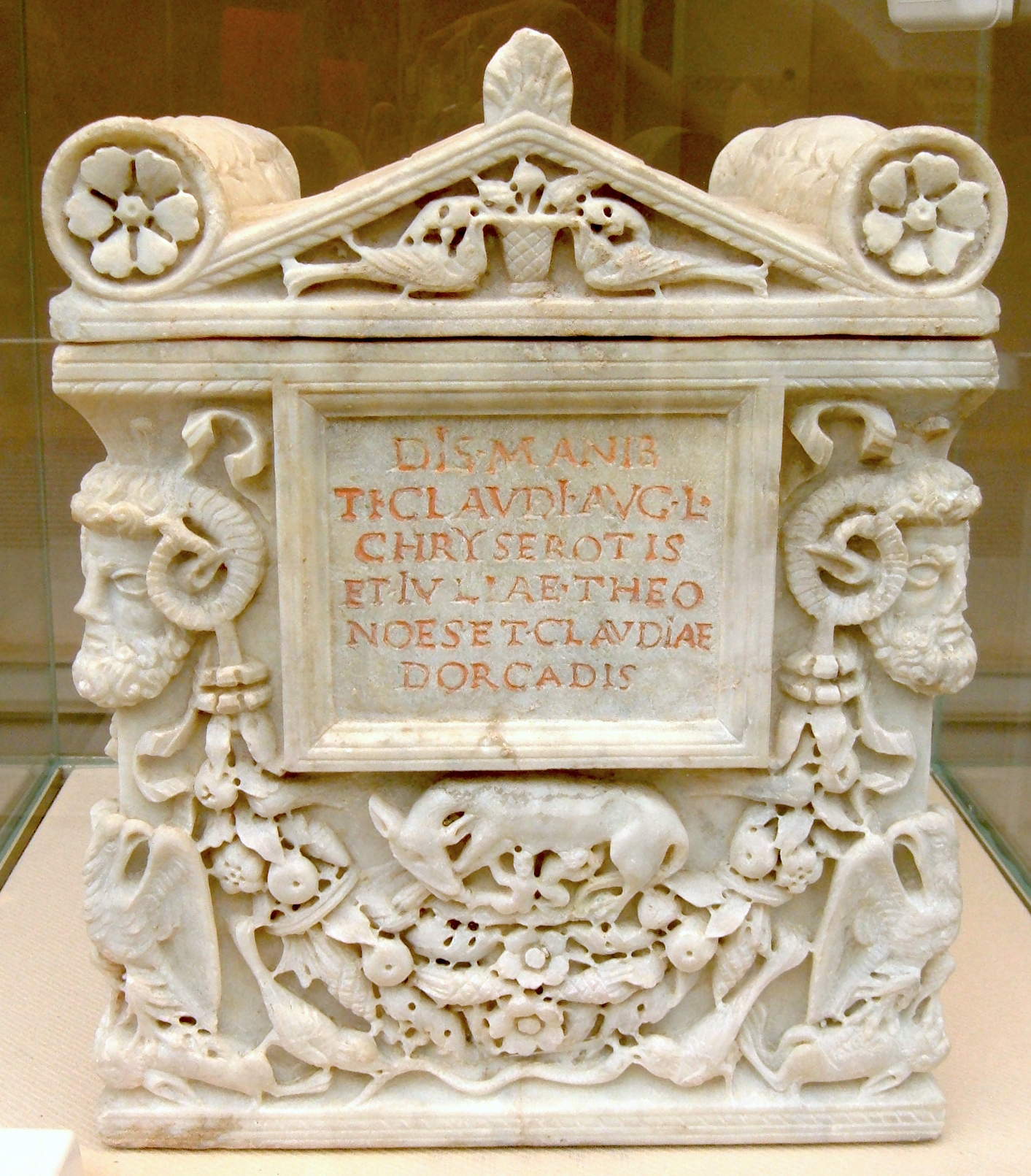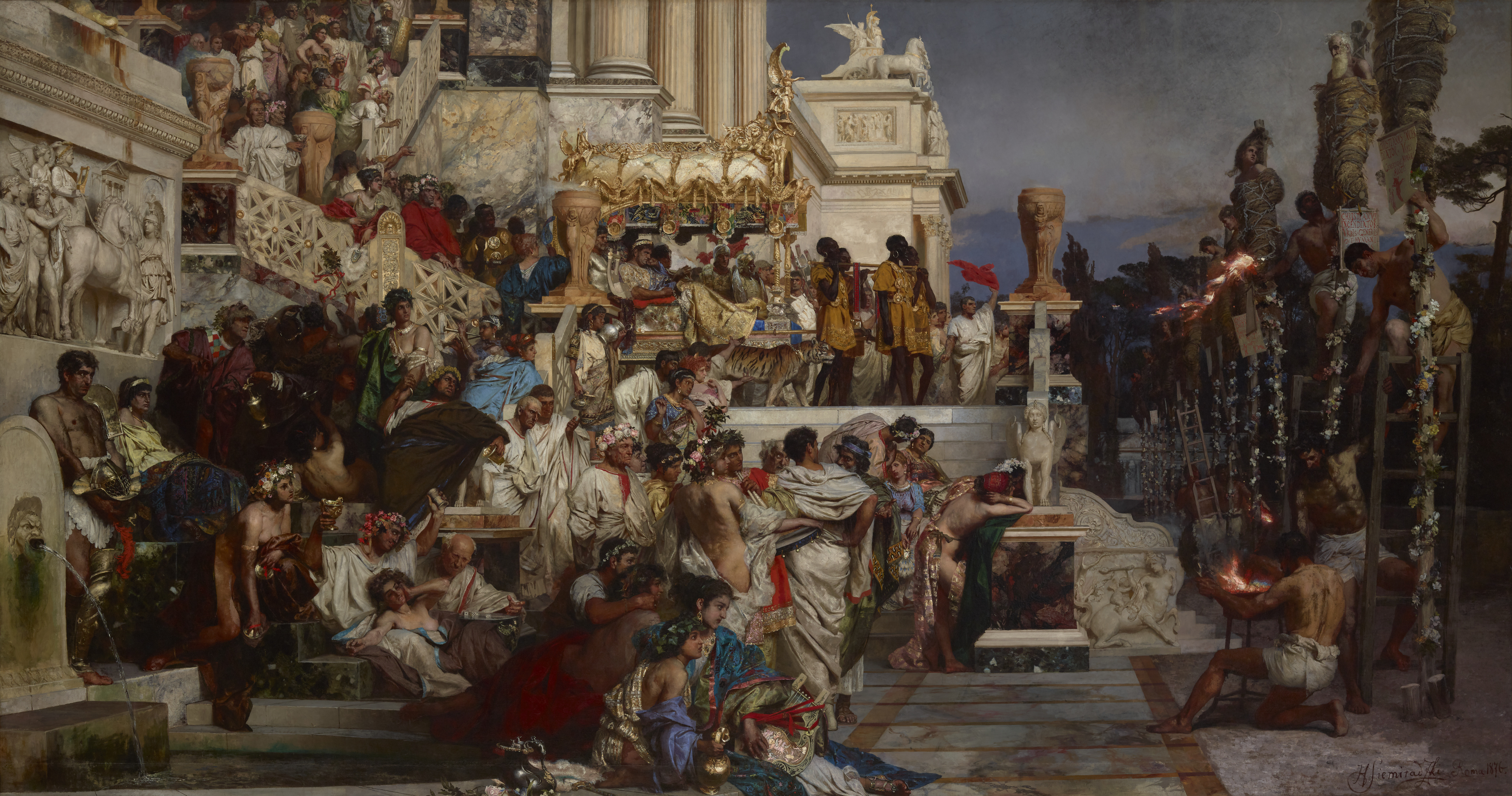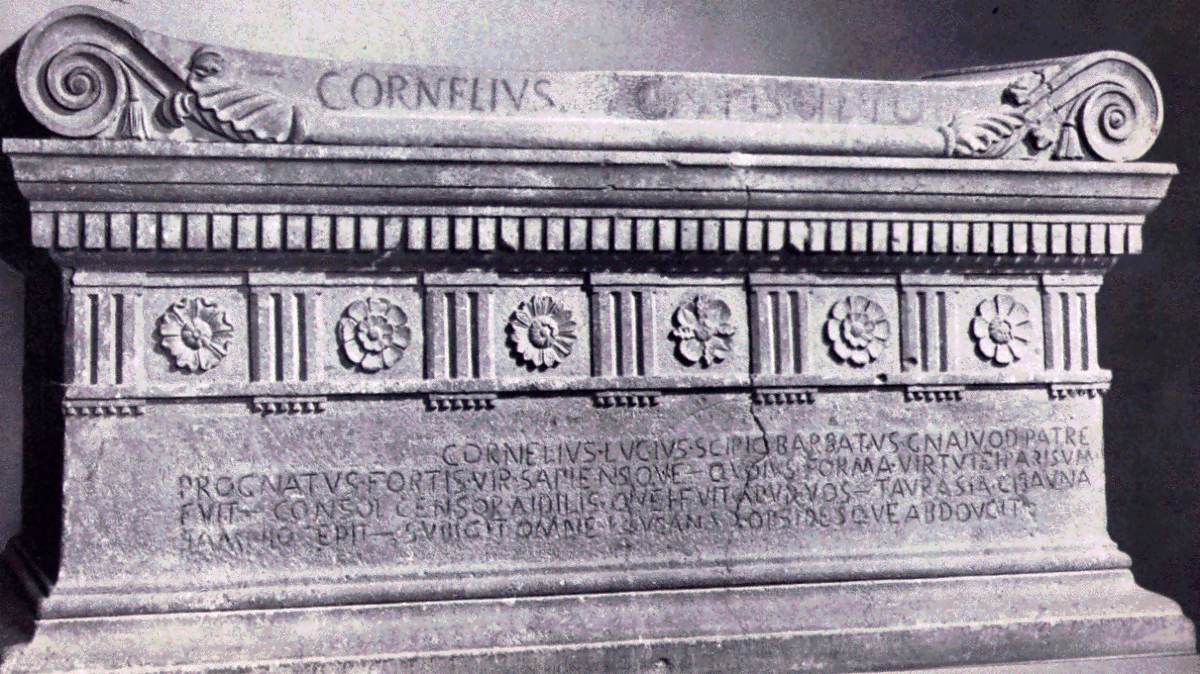|
Claudia Acte
Claudia Acte was a freedwoman of ancient Rome who became a mistress of the emperor Nero. She came from Asia Minor and might have become a slave of the Emperor Claudius, following his expansion of the Roman Empire into Lycia and Pamphylia; or she might have been purchased later, by Octavia, Claudius' daughter. Relationship with Nero The Emperor Claudius, uncle of Nero's mother, Agrippina the Younger, married his niece in 49 AD and therefore became Nero's stepfather. Claudius' daughter, Octavia (by his wife Messalina), became Nero's stepsister at the same time. Nero and Octavia themselves married in 53 AD, and Nero became emperor in 54 AD, after his great-uncle/stepfather died—apparently poisoned, in the belief of contemporary historians, by his niece/wife, Agrippina, Nero's mother. A year into Nero's reign, encouraged by Seneca the Younger and Burrus, and against Agrippina the Younger's wishes, Nero took Acte as his mistress. Seneca especially was concerned that his young s ... [...More Info...] [...Related Items...] OR: [Wikipedia] [Google] [Baidu] |
Freedman
A freedman or freedwoman is a person who has been released from slavery, usually by legal means. Historically, slaves were freed by manumission (granted freedom by their owners), emancipation (granted freedom as part of a larger group), or self-purchase. A fugitive slave is a person who escaped enslavement by fleeing. Ancient Rome Rome differed from Greek city-states in allowing freed slaves to become plebeian citizens. The act of freeing a slave was called ''manumissio'', from ''manus'', "hand" (in the sense of holding or possessing something), and ''missio'', the act of releasing. After manumission, a slave who had belonged to a Roman citizen enjoyed not only passive freedom from ownership, but active political freedom ''(libertas)'', including the right to vote. A slave who had acquired ''libertas'' was known as a ''libertus'' ("freed person", feminine ''liberta'') in relation to his former master, who was called his or her patron ''( patronus)''. As a social class, fr ... [...More Info...] [...Related Items...] OR: [Wikipedia] [Google] [Baidu] |
Tacitus
Publius Cornelius Tacitus, known simply as Tacitus ( , ; – ), was a Roman historian and politician. Tacitus is widely regarded as one of the greatest Roman historians by modern scholars. Tacitus’ two major historical works, ''Annals'' (Latin: ) and the ''Histories'' (Latin: ), originally formed a continuous narrative of the Roman Empire from the death of Augustus (14 AD) to the end of Domitian’s reign (96 AD). The surviving portions of the Annals focus on the reigns of Tiberius, Claudius, Nero, and those who reigned in the Year of the Four Emperors (69 AD). Tacitus's other writings discuss oratory (in dialogue format, see ), Germania (in ''De origine et situ Germanorum''), and the life of his father-in-law, Agricola (the general responsible for much of the Roman conquest of Britain), mainly focusing on his campaign in Britannia ('' De vita et moribus Iulii Agricolae''). Tacitus's ''Histories'' offers insights into Roman attitudes towards Jews, ... [...More Info...] [...Related Items...] OR: [Wikipedia] [Google] [Baidu] |
Rike Schmid '', spelled in Swedish and modern Norwegian, ''rige'' in Danish and ''riik'' in Estonian; analogous to the English word "realm"
{{given name, type=both ...
Rike or Ryke is a given name and a surname. It may refer to: * Rike Boomgaarden (), German singer and songwriter * Ryke Geerd Hamer (1935–2017), German physician whose license was revoked for originating and practicing a system of pseudo-medicine * Kjell Kristian Rike (1944–2008), Norwegian sports commentator See also * Rike Kumler Co., commonly known as Rike's, a former American department store in Dayton, Ohio * ''Reich ( ; ) is a German word whose meaning is analogous to the English word " realm". The terms and are respectively used in German in reference to empires and kingdoms. In English usage, the term " Reich" often refers to Nazi Germany, also ca ... [...More Info...] [...Related Items...] OR: [Wikipedia] [Google] [Baidu] |
Nero (2004 Film)
''Nero'' is an Italian-British-Spanish television film, part of the ''Imperium'' series; it was made film available on DVD as of November 2005 in the U.S. and Canada. Produced by EOS Entertainment and Lux Vide for RAI and Telecinco. Plot As a young boy, Lucius Domitius Ahenobarbus witnesses the mad Emperor Caligula kill his father and exile his mother. While in exile in the pontine islands, Agrippina, his mother, sees a vision telling her that her son can become emperor, but she will have to die first. She accepts the proposal. Back in Rome, her son is being raised by the new emperor Claudius after Caligula's death, he is now called Nero Claudius Caesar Drusus Germanicus. Agrippina then returns from exiled. She poisons Claudius' food and Nero becomes emperor. At first, Nero cuts taxes and introduces successful programs and invades Brittania. Soon he meets a beautiful slave named Claudia Acte, and marries her, throwing off his engagement with Claudius' daughter, Claudia Octa ... [...More Info...] [...Related Items...] OR: [Wikipedia] [Google] [Baidu] |
Quo Vadis (novel)
''Quo Vadis: A Narrative of the Time of Nero'' () is a historical novel written by Henryk Sienkiewicz in Polish. The novel ''Quo Vadis'' tells of a love that develops between a young Christian woman, Lygia (Ligia in Polish), and Marcus Vinicius, a Roman patrician. It takes place in the city of Rome under the rule of emperor Nero, from to AD 68 when Nero committed suicide. Sienkiewicz studied the Roman Empire extensively before writing the novel, with the aim of getting historical details correct. Consequently, several historical figures appear in the book. As a whole, the novel carries a pro-Christian message. It was first published in instalments in the ''Gazeta Polska'' between 26 March 1895 and 29 February 1896, as well as in two other journals, ''Czas'' and ''Dziennik Poznański'', starting two and three days later. It was published in book form in 1896 and has been translated into more than 50 languages. The novel contributed to Sienkiewicz's Nobel Prize in Literature ... [...More Info...] [...Related Items...] OR: [Wikipedia] [Google] [Baidu] |
Henryk Sienkiewicz
Henryk Adam Aleksander Pius Sienkiewicz ( , ; 5 May 1846 – 15 November 1916), also known by the pseudonym Litwos (), was a Polish epic writer. He is remembered for his historical novels, such as The Trilogy, the Trilogy series and especially for his internationally known best-seller ''Quo Vadis (novel), Quo Vadis'' (1896). Born into an impoverished szlachta, Polish noble family in Russian-ruled Congress Poland, in the late 1860s he began publishing journalistic and literary pieces. In the late 1870s he traveled to the United States, sending back travel essays that won him popularity with Polish readers. In the 1880s he began serializing novels that further increased his popularity. He soon became one of the most popular Polish writers of the turn of the 19th and 20th centuries, and numerous translations gained him international renown, culminating in his receipt of the 1905 Nobel Prize in Literature for his "outstanding merits as an epic writer". Many of his novels remain in ... [...More Info...] [...Related Items...] OR: [Wikipedia] [Google] [Baidu] |
Pincian Hill
The Pincian Hill ( ; ) is a hill in the northeast quadrant of the historical centre of Rome. The hill lies to the north of the Quirinal, overlooking the Campus Martius. It was outside the original boundaries of the ancient city of Rome, and was not one of the Seven hills of Rome, but it lies within the wall built by Roman Emperor Aurelian between 270 and 273. Villas and gardens Several important families in Ancient Rome had villas and gardens (''horti'') on the south-facing slopes in the late Roman Republic, including the Horti Lucullani (created by Lucullus), the Horti Sallustiani (created by the historian Sallust), the Horti Pompeiani, and the Horti Aciliorum. The hill came to be known in Roman times as ''Collis Hortorum'' (the "Hill of Gardens"). Its current name comes from the Pincii, one of the families that occupied it in the 4th century AD. Modern Rome The Pincio as seen today was laid out in 1809–14 by Giuseppe Valadier; the French Academy at Rome had mo ... [...More Info...] [...Related Items...] OR: [Wikipedia] [Google] [Baidu] |
Ahenobarbus (other)
Ahenobarbus (Latin, 'red-beard', literally 'bronze-beard'), also spelled Aenobarbus or Ænobarbus, may refer to: * Gnaeus Domitius Ahenobarbus (other), Romans * Lucius Domitius Ahenobarbus (other), Romans * Lucius Domitius Ahenobarbus, birth name of Nero, Roman emperor 54–68 * Frederick Barbarossa Frederick Barbarossa (December 1122 – 10 June 1190), also known as Frederick I (; ), was the Holy Roman Emperor from 1155 until his death in 1190. He was elected King of Germany in Frankfurt on 4 March 1152 and crowned in Aachen on 9 March 115 ..., known in Latin as ''Fridericus Ænobarbus'', Holy Roman Emperor 1155–1190 See also * {{disambiguation ... [...More Info...] [...Related Items...] OR: [Wikipedia] [Google] [Baidu] |
Pyre
A pyre (; ), also known as a funeral pyre, is a structure, usually made of wood, for burning a body as part of a funeral rite or execution. As a form of cremation, a body is placed upon or under the pyre, which is then set on fire. In discussing ancient Greek religion, "pyre" (the normal Greek word for fire anglicized) is also used for the sacred fires at altars, on which parts of the animal sacrifice were burnt as an offering to the deity. Materials Pyres are crafted using wood. The composition of a pyre may be determined through use of charcoal analysis. Charcoal analysis helps to predict composition of the fuel and local forestry of the charcoal being studied. Ireland Specifically, in the Bronze Age, pyre materials were gathered based on local abundance and ease of access to the wood although materials were also selected due to the specific properties, potential traditional purpose, or due to economical reasons. In Templenoe, pyres typically consisted of oak and fruit ... [...More Info...] [...Related Items...] OR: [Wikipedia] [Google] [Baidu] |
Roman Funerals And Burial
Roman funerary practices include the Classical antiquity, Ancient Ancient Romans, Romans' Ancient Roman religion, religious rituals concerning funerals, cremations, and burials. They were part of mos maiorum, time-hallowed tradition (), the unwritten code from which Romans derived their social norms. Elite funeral rites, especially processions and public Eulogy, eulogies, gave the family an opportunity to publicly celebrate the life and deeds of the deceased, their ancestors, and the family's standing in the community. Sometimes the political elite gave costly public feasts, games and popular entertainments after family funerals, to honour the departed and to maintain their own public profile and reputation for generosity. The Roman Gladiator, gladiator games began as funeral gifts for the deceased in high-status families. Funeral displays and expenses were supposedly constrained by sumptuary laws, designed to reduce class envy and consequent social conflict. The less well-off, a ... [...More Info...] [...Related Items...] OR: [Wikipedia] [Google] [Baidu] |
Sardinia
Sardinia ( ; ; ) is the Mediterranean islands#By area, second-largest island in the Mediterranean Sea, after Sicily, and one of the Regions of Italy, twenty regions of Italy. It is located west of the Italian Peninsula, north of Tunisia and 16.45 km south of the French island of Corsica. It has over 1.5 million inhabitants as of 2025. It is one of the five Italian regions with some degree of Autonomous administrative division, domestic autonomy being granted by a Regions of Italy#Autonomous regions with special statute, special statute. Its official name, Autonomous Region of Sardinia, is bilingual in Italian language, Italian and Sardinian language, Sardinian: / . It is divided into four provinces of Italy, provinces and a Metropolitan cities of Italy, metropolitan city. Its capital (and largest city) is Cagliari. Sardinia's indigenous language and Algherese dialect, Algherese Catalan language, Catalan are referred to by both the regional and national law as two of ... [...More Info...] [...Related Items...] OR: [Wikipedia] [Google] [Baidu] |
Puteoli
Pozzuoli (; ; ) is a city and (municipality) of the Metropolitan City of Naples, in the Italian region of Campania. It is the main city of the Phlegrean Peninsula. History Antiquity Pozzuoli began as the Greek colony of ''Dicaearchia'' () founded in about 531 BC in Magna Graecia with the consent of nearby Cumae when refugees from Samos escaped from the tyranny of Polycrates. The Samnites occupied Dicaearchia in 421 BC after conquering Cumae and may have changed its name to Fistelia. It enjoyed considerable political and commercial autonomy favoured by the excellent position of its port with the Campanian hinterland. The Roman occupation of Campania after the end of the 1st Samnite War from 341 BC marked the start of the Romanisation of the Greek-Samnite city. During the Second Punic War (218–201 BC), Rome recognised the strategic importance of the port of Puteoli and reinforced the defences and introduced a garrison to protect the town from Hannibal, who failed to ... [...More Info...] [...Related Items...] OR: [Wikipedia] [Google] [Baidu] |





